GodSpeed;1399671 said:Since the inception of agriculture, mankind has been struggling against the constant predatory aspect of nature trying to eat the crop first. Animals and the elements are problems faced by outdoor growers, however everyone is put to battle with bugs at some point or another. Pests are a constant threat to any grower be it farm crops, a vegetable garden, or growing marijuana. Parasitic insects have been evolving for millions of years to infest, devour, and destroy plant matter in order to ensure their own proliferating survival. . . . and they're professionals. This thread will focus on prevention, identification and eradication of blights afflicting marijuana growers today.
PREVENTION
It has been said over and over that an ounce of prevention is worth a pound of the cure and I cannot reiterate this maxim enough. Prevent outbreak first and foremost then treat if necessary. Basic cleanliness can help on a massive scale to ensure you never walk up to your garden to have a flood of pests greet you. You work hard and spend harder earned money to produce a crop of smoke, don't risk creating a bug buffet by casual laziness. The following are the major rules to follow in basic pest and disease prevention.
Always
-Use compost that has been processed properly. A medium heated to 140F/60C will kill larvae, eggs and fungus that is residing there. Cutworms eggs are very common in manure and compost, the marijuana plant has no defense against cutworms rampaging through its roots. When properly composted, both mediums reach these temperatures. Check for the seal of a regulating authority certifying the product. Guarantees are nice to see as well.
-Do not use mulch. This easy-accessible, moist, shaded medium is a perfect retreat for incoming pests and fungus. The risk isn't worthwhile.
-Keep outdoor tools outside, and indoor tools inside. If there are parasites in either garden, there will be hitchhiking mary jane munchers clinging to them. Tools used for regular yard work should always be sterilized if brought indoors. Rubbing alcohol, soap and water, or a quick pass with a handheld torch will accomplish this nicely.
Outdoors
-Spray regularly with a pesticide targeted at worms and mites. Returning with the regularity necessary to eradicate an infestation is not usually possible. Check the surrounding area for presence of pests and treat preventively. Spraying should commence in early to mid-summer. This is when the larvae of most pests are becoming fully mobile and airborne. Pesticide should be reapplied every few weeks.
-Companion planting is useful as it discourages insect populations. Transplanting foliage with similar characteristics to cannabis will spread out incoming populations of insects allowing the predatory nature of the outdoors to take its course. Additionally, transplanted companion plants will likely become infected prior to your plants giving you the opportunity to halt their spread before it touches your bud. Please, use common sense and inspect companions before transplanting them. Companion planting is useless indoors as bugs have nowhere else to go.
Indoors
-Keep your growroom a closed space in order to control the environment
-Forced air circulation is one of your chief weapons against bugs. Powerful ventilation ensures spores and smaller flying insects do not have opportunity to proliferate. Winds created by oscillating fans make it difficult for bugs to hold on or set up nests.
-You should regard outdoor shoes as radioactive inside your growroom. They are easily the most disease and pest infested item of clothing you own.
-Wash your hands! Hands are dirty, and you will be coming in direct contact with your bud. Don't come back from a hike in the woods and walk into your growroom. Don't play with your dog, check your vegetable garden and walk into the holiest of holies. Wash up!
-Sweep always, mop often, keep debris off your medium. Do not provide condo's to incoming insects, a broom is far cheaper than pesticide.
-If your air intake comes from outside, install a filter designed for heating and cooling systems. These commercial filters are designed to keep pests and disease outside.
Healthy plants will be the best defense you can possibly have. Often marijuana grows quickly enough to outpace pests, especially when healthy.
IDENTIFICATION AND TREATMENT
No matter the preventative measures you engage in, a pest population will infiltrate your crop eventually. For you growers with larger gardens, keep your eyes on weak plants! Pests infect one plant first, build up numbers and launch an offensive on every nearby edible object. I once was visiting a compatriot's grow underneath a 4 season porch with 24 plants. The plants on the left were doing very well, but the farther to the right the garden went, the more destroyed his crop had become. Some species of boring worm had successfully attacked a sick plant in a corner. When he discovered the infiltration point, the plant was essentially dead where it stood, worms crawling through almost the entirety of its stalks. From that plant, the worms spread quickly enough to destroy 15 of his 24 plants. Most insects lay thousands of eggs during their lifespan of weeks. If ten pests lay 100 eggs and their offspring each lay 100 eggs, your pest population has jumped from 10 to 100,000. This can occur in DAYS. Pay special attention to sickly plants, the evolutionary process dictates vulnerability to preying organisms. Men greater and wiser than I have adamantly stated that using chemicals on plants destined to be inhaled should ALWAYS be used as a last resort. Commercial and chemical pesticide have the creatures they eradicate listed on the label. Remember if you do choose to use chemicals that you will be lighting this stuff on fire and inhaling the smoke. If you have to use a nuke, allow enough time for the radiation to die down capeesh? Use these long before harvest. This article will focus on organic and non-toxic pest control.
There are four methods you can employ to combat pests.
-Repression: If the means to exterminate your particular bug isn't immediately available, there are usually countermeasures you can take to slow infestations or decrease numbers of current pests. Taking these countermeasures during treatment further increases the effectiveness of the method you choose to utilize.
-Predators: The internet has opened up the world to the grower for specific predatory insects that will dine or destroy others voraciously. Most predators identified in this article are so specialized the specific pest is completely defenseless.
-Manual removal: Exactly what it sounds like. Picking the things off, crushing eggs, removing branches that have colonies in place. If caught early enough, manual removal can control pests sufficiently they will not fully infest your plants.
-Spray: When applying pesticide in a spray, ensure you use a spreader sticker. This is any type emulsifier that aids the pesticide in sticking to the leaves and commercial products are readily available for purchase. When your plant is budding this is especially necessary because the leaves of your plants are developing coatings of resin that will shed what you are spraying. If not purchasing a product, a teaspoon of dish soap per gallon of water will work fine. Jorge Cervantes tells us that any type of spray applied to plants will slow its growth temporarily as it will clog the stomata on the underside of leaves. Spraying water 1-2 days after application of a spray can help to clear stomata and aid the plant in resuming vigorous growth.
Lets get to the beasts shall we? The prevention sections will be all but useless to the outdoor gardener, however the treatments will be equally effective. Pests are listed alphabetically and predators are identified by exact species to avoid any confusion.
Aphids

Prevent: Aphids are most present indoors when lots are present outdoors. The aphid CAN fly when looking for a new home. Sticky traps placed on the floor near plants and hanging near the top will help discourage their forays indoors.
Identify: Aphids are usually grey but can range to any color. Regardless of their color, aphids will feast on any part of your plant by biting into leaf, stem, and bud alike while sucking the life out of the plant. Once attached, the aphid becomes stationary and fairly easy to spot. A 10x magnifier will be sufficient for positive identification. Female aphids do not require mating to reproduce and will excrete a live female offspring between 3 and 100 times every day. These offspring are hungry! Ants parading around the base of your plant can also be a sign of aphid infestations. Ants naturally farm aphids to feed off their excretions. Aphids suck sap from reaching your plant's tissues causing leaves to wilt and turn yellow. After infestation has progressed you may notice buildup of aphid excretion called honeydew. APHIDS WILL TARGET WEAK PLANTS LIKE NO OTHER PARASITE!

Eradicate
Repression: If your plant can survive in a set of conditions, the aphid can as well.
Predators: The Lacewing (Chrysoperia species) is the most effective and available predator to wipe out aphids. The larvae of this flying insect tear through aphid colonies voraciously. Release 1-20 lacewings per plant depending on infestation level as soon as aphids appear, their eggs take a few days to hatch. Of course the ladybug is also an excellent predator to the aphid and freely available, especially during summer. Indoor gardeners may choose to utilize the lacewing instead of the ladybug due to its incredible attraction to HID lights. If you indoor boys use ladybugs, plan on 50% (no exaggeration) of them dying immediately from flying directly into the bulb. Within 7-10 days, all the ladybugs will have committed suicide in an HID garden. Verticillium lecanii is a fungus that is very aphid specific and effective.
Manual removal: This is a very effective treatment against aphid infestations. Once the aphid begins feeding it is immobile and easily crushed with fingers or a sponge containing an insecticidal solution.
Spray: Insecticidal soap, pyrethrum (aerosol) and homemade sprays are very effective. Apply two or three times daily at 5-10 day intervals.
Beetle Borers
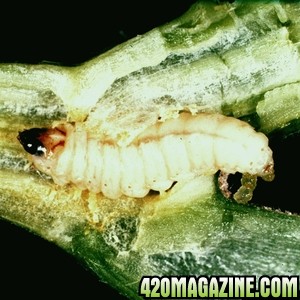
Prevent: Beetle borers are primarily found in outdoor gardens. Cleanliness and good habits will keep these pests out of greenhouses and indoor growrooms.
Identify: The beetle borer is the larvae of a large variety of beetles and a particularly nasty pest. These larvae leave entry holes at the base of stalks where they continue chewing through the stems of your plant. A brown trail of death will follow the path of a beetle borer, these pests cause severe enough damage to water transportation systems of plants everything around the trail dies. If the base of branches or heaven forbid the main stem of the plant are infected, death can quickly follow for everything outwards of the trail.
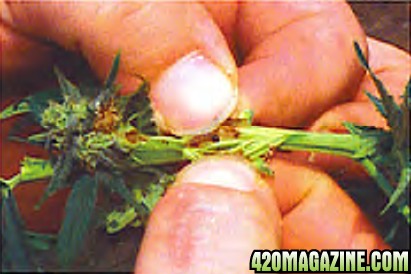
Eradicate
Repression: Keeping indoor grows clean is the only countermeasure.
Predators: The borer is a large enough tunneling insect that no effective predator has been identified. Predatory nematodes can help control grubs in the soil but this is a largely preventative measure and not a treatment.
Manual Removal: The best and virtually only way of controlling beetle borers. If damage is sited, follow the trail and cut the borer out of your plant. Oftentimes damage is already done when a beetle borer is located. If the branch or affected area does not bounce back quickly or is obviously done for, remove it with a clean cut from a knife or scissors.
Spray: The beetle borer lives inside the hardy stalks of your plant making sprays nearly useless. Bacillus papillae is a beetle specific fungal powder and can have limited success. If the beetle is in the main stem of your plant and you cannot get to it without endangering the life of your plant, injecting a product called rotenone directly into the stalk with a hypodermic syringe will kill the grub.
Caterpillars and Loopers
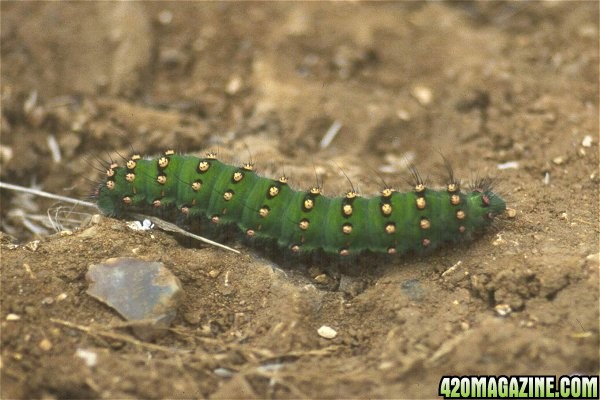
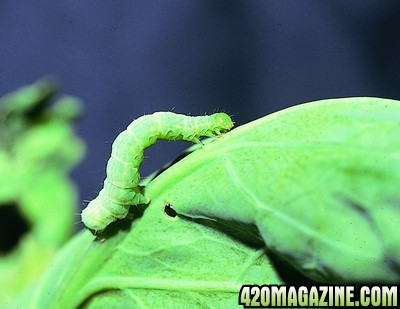
Prevent: These pests are the larval stage of moths and butterflies. Both moths and butterflies take a small measure of time to lay their eggs, easy to spot, and cannot hang on to plants when forced air circulation is employed properly. Loopers and caterpillars are therefore primarily an outdoor pest.
Identify: A caterpillar has lots of legs. Loopers have sets of feet at both ends and arches its back to pull its rear feet forward. These worms can be any color, any size above half an inch, and are the industrial shit machine of the insect kingdom. These worms will chew through leaves, buds, stalks, and even the main stem leaving trails of caterpillar poop wherever they go. Fungus and rot quickly follow when this type of fecal matter is present, caterpillars and loopers are a central figurehead of natural decomposition. Caterpillars and loopers primary damage is mass defoliation. If you feel these pests may be present, a quick spray of pyrethrum followed by a shake to your plant will cause some of them to fall out of wherever they are.
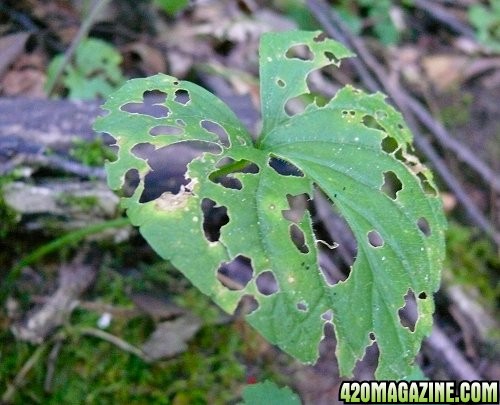
Eradicate
Repress: These worms live in any conditions your plant can, are laid by adult moths and butterflies, and do not reproduce until later in their adult stage. Repress by not letting more moths into your garden!
Predators: The parasitic wasp Trichogramma is effective in combating caterpillars and loopers. This wasp, as all parasitic wasps do, lays its eggs on the caterpillar and the hatching larvae eat the worm alive.
Manual Removal: Pick them off and crush them.
Spray: A homemade mix of hot pepper and garlic, a Bt pesticide, or repeated doses of pyrethrum.
Fungus Gnat
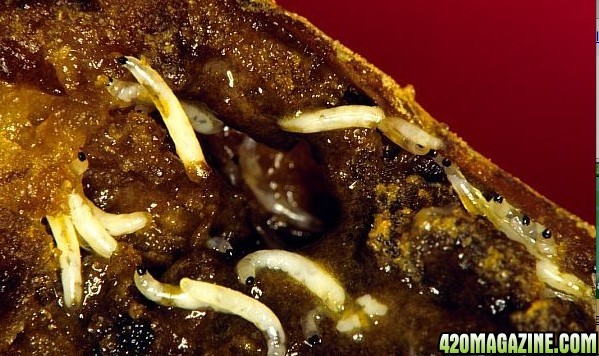
Prevent: Do not overwater, keep the relative humidity of your garden low, do not let the surface of your grow medium stay soggy. Cover hydroponic medium surfaces to prevent growth of green algae.
Identify: Fungus gnats attack your plant in their adult stage and larval stage. The maggot of the fungus gnat is almost invisible to the human eye with see-through bodies and a black head. These maggots infest the upper roots of your plants and can spread throughout the entire root system in hydroponic mediums. Maggots love dark, dank, moist, soaked environments. Check the medium at the base of your plant for these pests, fungus gnat larvae are notoriously happy in rockwool. These creatures infest root systems, damaging larger roots and consuming root hairs. This causes your plant to weaken, slow its growth, and fading in the foliage. These wounds to the roots make marijuana insanely vulnerable to several types of fungus. Maggots love dying plant matter and will only infest more heavily the more damaged your plant becomes. Adult gnats are grey to black, very small and have very very long legs. Females lay eggs prolifically at the rate of 200 eggs weekly and will usually be found at the base of your plant along with maggots. Additionally, these little pests will stick to your sticky flowering green like crazy and are basically impossible to remove.

Eradicate
Repression: Reducing surface moisture in your plants medium will slow fungus gnats reproductive cycle dramatically, the drier the better. Applying an anti-algae product around the bases of your plant will kill any growing green algae and reduce the food sources of growing maggots. Yellow sticky traps placed 2 inches from the base of your medium will snag a good chunk of departing adults.
Predators: Introducing a predator for the gnats themselves has proved ineffective at eliminating a population. The predatory soil mite Hypoaspis and nematode Steinemema feltiae will severely impact the insect population if introduced to soil grows. These creatures will not be effective countermeasures in hydroponic application.
Manual Removal: Impossible. You can swat a few but your threat is from what has already been laid underground.
Spray: Neem or insecticidal soap applied as a soil drench will kill eggs and larvae present in 1-3 applications. Any pesticide spray containing the fungal culture Bacillus thuringiensis var. israelensis (Bt-i) will successfully eradicate adult gnats. Apply soil drenches and spray simultaneously every 5-10 days.
Leaf Miner Maggots
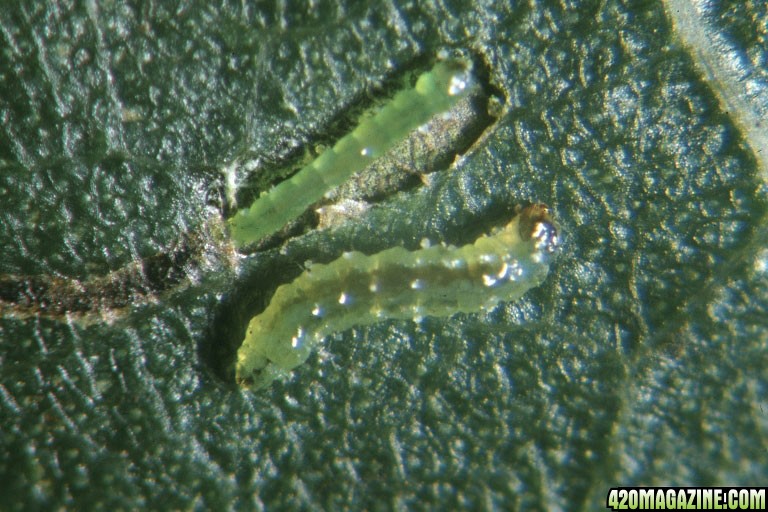
Prevent: Environmental control indoors and in greenhouses will prevent the leaf miner fly from laying its eggs in your plant.
Identify: Leaf miners are maggots usually 1/8th inch thick when hatching. It is very rare that a grower will notice them before they notice the damage they cause. These maggots burrow through leaves leaving brown and light green trails behind them. The maggot will usually be visible inside the leaf it is burrowing through.
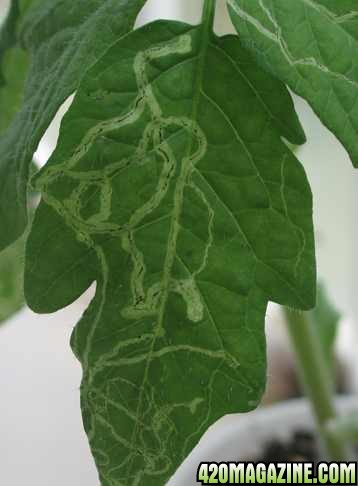
Eradicate
Repression: Leaf miner maggots live inside tunnels in your plant and are well protected against measures you take against them. Yellow sticky traps are effective for adult leaf miner flies.
Predators: The parasitic wasps Dacnusa sibirica, Diglyphus isaeo, or Opius pallipes are effective predators of maggots.
Manual Removal: Crush the maggots inside leaves with your fingers, doing so is easy given they trap themselves inside the leaves. Cut infested leaves off your plant and burn them or treat in excess of 140F/60C.
Spray: Sprays are ineffective against these maggots as they are entirely protected within their tunnels. Water your plant with a .5% solution of neem, this works very quickly and will stay in your plants tissues for around 4 weeks successfully repelling any further incursions.
Nematodes
There are hundreds of thousands of different species of nematode, some are harmful to marijuana but these are rare. Most often they attack roots but some attack the upper sections of the plant. Nematodes that are harmful to marijuana plants are for the most part microscopic, and the varieties that are visible are so rare you'd have a better chance being struck by lightning. If your plant is growing slowly, turning yellow and dying, or being slowly eaten away with no visible signs you MIGHT have harmful nematodes. Nematode infestation closely resembles nitrogen deficiency. Taking a soil sample is the best method of detecting nematodes. Take a small tube and punch a core sample out of soil, or inspect hydroponic roots carefully. Roots being attacked by nematodes will be soft, mushy, and beginning to fall apart. The best countermeasure to not contracting nematodes is to use clean soil every time. It takes a fair amount of time for a infesting nematode to build up sufficient numbers to attack your plant, re-using soil invites these circumstances. Nematodes can be eradicated with a neem soil drench and neem oil applied as a spray.
Root Maggot
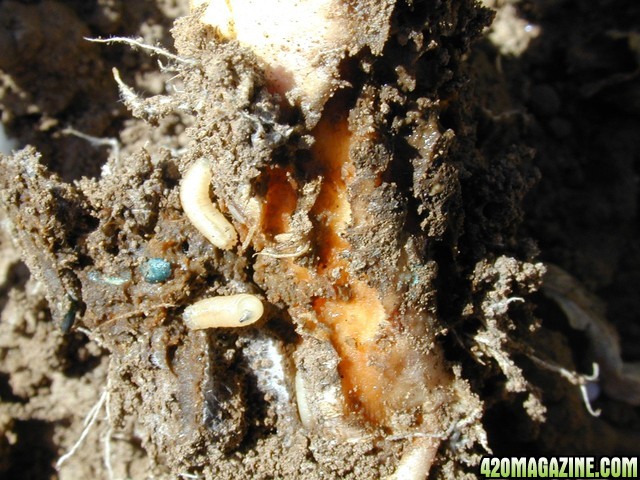
Prevent: Use new or sterilized soil every time you grow. Maggot eggs stay dormant until spring and love areas containing plant roots. Place an 18-inch collar of foam rubber around the base of the plant to ensure flies cannot lay their eggs.
Identify: Maggots eggs are deposited by seed corn or cabbage flies visiting the base of your plant. If your plant becomes less stable, yellows or darkens severely at the base of its stalk, or ceases growing larger you should check the loose soil at your plant's base. If the white wriggly bastards are there, they are already busy at work chomping through your plants roots until they transform into flies, lay more eggs, and fly to another plant.

Eradicate
Repression: Maggots will be undetectable until hatched.
Predators: Parasitic nematodes Steinernema feltioe or Heterorhabditis bacteriophara will control maggots
Manual Removal: Impossible given the damage is taking place underground.
Spray: Using a soil drench of neem and horticultural oil will poison all root maggots and maggot eggs that are present.
Slugs and Snails
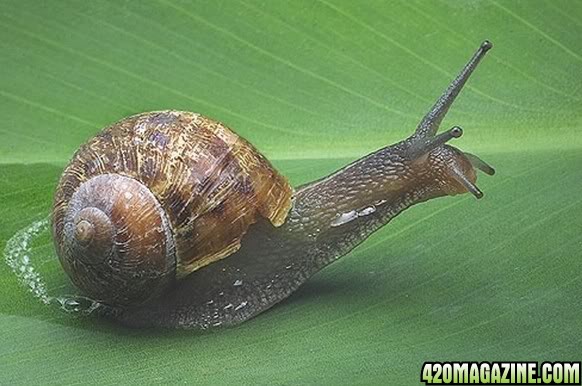

Prevent: A flat, dry area surrounding your plants will make passage for these creatures difficult
Identify: They look like the picture above. Slugs and snails (and puppy dogs tails) create web-shaped holes in foliage. Slugs and Snails can easily kill seedlings and clones

Repress: Indoors push the humidity as low as possible, this will impair movement and force the pests toward water. A thin line of diatomaceous earth or salty sand will create an impassable barrier, or a 'wall o death' if you will. A copper ring on the bottom of your plant's stem will also keep these pests from climbing upwards.
Eradicate: Spray with a 50/50 ammonia/water solution. Ammonia penetrates the pest's skin immediately and causes a rapid death.
Spider mites
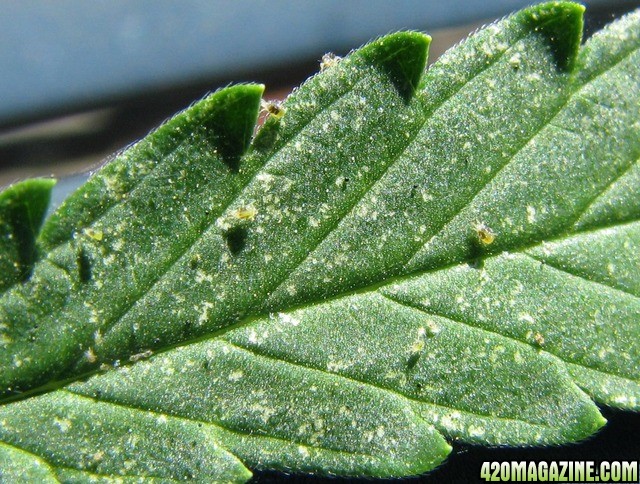
Prevent: Keep your growroom clean. Fully disinfect growroom with pesticide and 5% bleach solution before growing again after infestation.
Identify: A spider mite lives underneath the leaves of your plant and is invisible to the naked or untrained eye. These mites exist by sucking liquid that keeps your plant alive. They have eight legs and are classified a spider rather than an insect. Spider mites will be fully visible under a magnifying glass of 15x or greater. The mites are yellow/white, red, or most commonly are brown with two spots. These mites will spin webs which are a little easier to spot, but unfortunately mean the mites have been around awhile. Misting undersides of leaves will make webs much more visible and aid in detection. Females become fertilized for life once they mate and lay about 100 eggs every 5 days. 75% of all spider mite eggs become female.
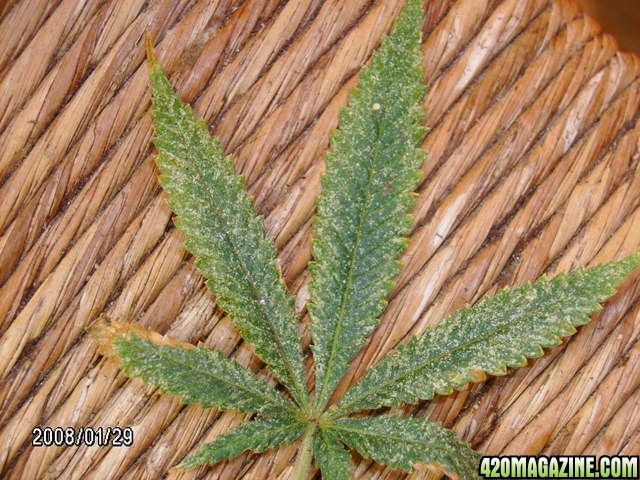
Eradicate
Repression: Mites thrive in temperatures of 70-80F/21-27C with average to high humidities. Cooling off your room to 60F/16C and dropping the relative humidity will slow the reproduction and damage rate of the spider mite. 50% humidity and below is where they get uncomfortable. Spraying jets of water across undersides of leaves will literally blast colonies loose and slow the march of these pests considerably.
Predators: Neoseiulus (Amblyseius) californicus and Mesoseiulus (phytoseiulus) longipes are the two most common and effective predators available for purchase. These predators can eat 20 eggs or 5 adults daily and die when their food supply (i.e. spider mites) has been exhausted. 20 predators per plant is a good jumping off point.
Manual removal: The tiny size of the spider mite makes manual removal ineffective.
Sprays: Neem oil is the most effective. Other effective methods are pyrethrum, horticultural oil, and insecticidal soap. Spraying three times at 5 to 10 day intervals should be sufficient to destroy a mite population if sanitary conditions are maintained. Eggs of the spider mite hatch in 5-10 days. The first spray kills adults, the second will destroy newly hatched mites, and the third will kill the stragglers. If you choose to use pyrethrum, rotate to another chemical if you spray frequently. This will ensure mites will not develop a resistance to synthetic pyrethrum. BE CAREFUL IN CHOOSING A CHEMICAL MITICIDE IF YOU CHOOSE TO DO SO! Several miticides have DDT or fungal relatives that are toxic if inhaled by humans!
Symphilids
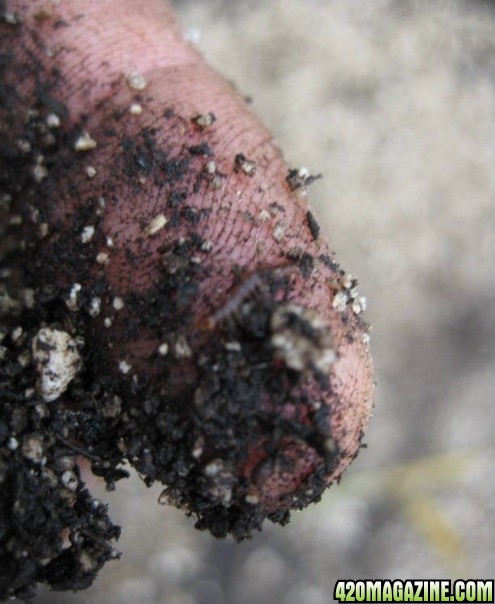
Prevent: The Symphilid hatches from eggs that are deposited constantly over the course of the females life. This pest is most commonly found in used soil, manure, and compost that has not been sterilized. Always use new soil and ensure your compost or manure is fully sterilized before using in your garden. Wash your hands before coming into your garden from outdoors.
Identify: These pests live underground and feed on roots. Usually not found in hydroponic gardens, this is a burrowing arthropod and has difficulty living without soil. The adult female Symphilid is the larger of the two reaches a maximum of 6mm long and lays eggs constantly wherever she travels year round. Eggs are fully grown in 3 months as this is a slower moving infestation. The trade off is this pest can live for years and is constantly voracious. When not covered in dirt, the symphilid is white and resembles a millipede. These pests chew through your root hairs like candy, the bigger the root system the bigger the colony. If left unchecked, these pests will result in the death of anything growing in infested soil. The root damage these pests inflict renders roots defenseless against fungus. Watering roughly can aid in detecting these pests, they float! If your water mixes up the top inch or two of soil, watch for tiny worm looking things zipping for cover. The Symphilid can frustrate many attempts at eradication and is capable of burrowing up to 7 feet deep into soil to escape harsh conditions.
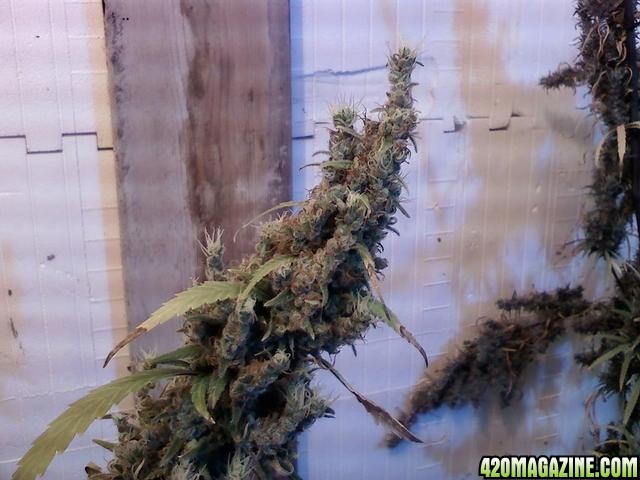
Eradicate
Repression: Reduce the moisture of your soil to the bare minimum. Symphilids burrow deep underground when they sense drought however they will not entirely leave a food source. Dry conditions will force these root chompers deeper into the ground and away from the central root ball of your plant. Root damage will continue, but in a less dangerous location. Ironic that watering is the simplest detection and drought is the stopgap.
Predators: The symphilid is native to new zealand and little is known about their biology. With over 160 species in a vague field there is not a effective predator that will work across species. The symphilid moves too quickly for predatory mites to be effective.
Manual Removal: Alas, the recourse of manual removal against underground pests is always minimal. If you sight these pests on the surface of your soil, kill them! This is a slower moving infestation and killing a few females will aid your plant more than you think.
Spray: Symphilids require very thorough soil drenching to eradicate. Other root munching pests do not have the depth capabilities of this creature, ensure your ENTIRE medium is soaked or you will see reappearance. Symphilids are resistant to oils and soaps and their eggs are tougher than any root predator in this thread. A simultaneous application of tobacco juice and neem as a soil drench has proven effective against the symphilid. 10 cigarettes per gallon of water, soaked until the water color is between tea and coffee is sufficient. Apply this juice alongside a neem drench twice spaced 4 days apart. If symphilids appear eradicated, take a soil sample from the bottom of your container, inspect, and re-drench if necessary.
Thrips
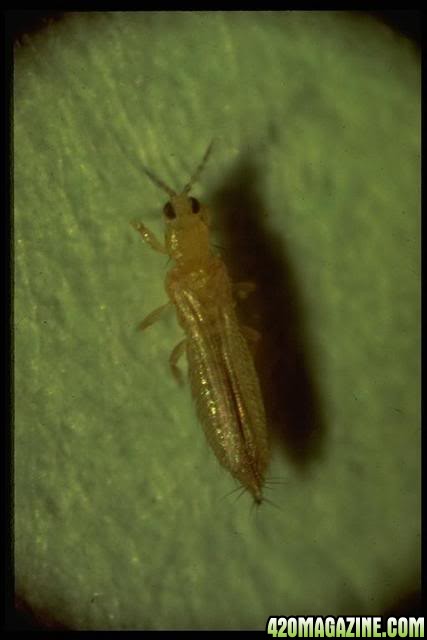
Prevent: Keeping clean habits is the only defense against a thrip infestation. These tiny insects will go unnoticed even by the most cautious grower until they reach damaging levels.
Identify: The thrip is commonly a greenhouse pest. It is difficult for the thrip to reproduce in large quantities outdoors and they must hitchhike into indoor gardens. These little guys are TINY! Thrips can be almost any color, move very quickly and have wings. They can be hard to see individually however detection should not be difficult. Thrips have a tendency to move in herds together, ripping tiny strips off the top of your leaves and drinking juices below. This can deprive plants leaves of chlorophyll so thoroughly they become brittle, dark, and crumble. Tiny black lines present across leaf surface, thats their toilet. The flying thrip can easily infest your garden very quickly if protected from outdoor conditions. The female thrip bores a hole into plant matter and leaves her eggs there in a hole so small you will need a magnifying glass to even know it is there. Apologies, I've been saving the worst for last. In marijuana the thrip prefers to thrive, eat, shit and reproduce primarily inside buds. Shaking branches will send these pests flying and jumping for other places.

Eradicate
Repression: Forced air circulation using powerful enough fans to move air throughout your greenhouse or growroom can keep the thrip from being able to hang on or move. Regular misting of water will flood the thrips on the leaves and slow their travel, reproduction, and ability to damage your plant. Sticky traps will help, however the thrip is happy eating in the same area for its entire life cycle. Low migration reduces effectiveness of sticky traps.
Predators: Nearly any predatory mite is effective in combating thrips. Parasitic wasps may also be used, however the sheer numbers of thrips limits their ability.
Manual Removal: You might be able to see herds of the tiny specks moving around your plant, crushing these will reduce their numbers of course but is not effective overall.
Spray: Pyrethrum or insecticidal soap sprayed 2-4 times at 5-10 day intervals will nuke thrips back to the stone age.
Whiteflies
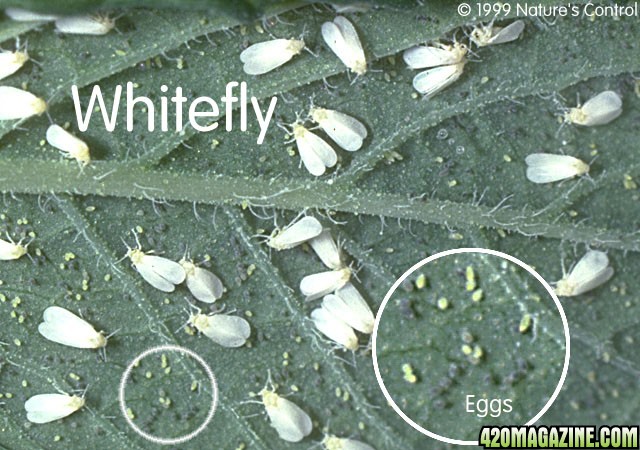
Prevent: If there are whiteflies in your area, sticky traps will catch whiteflies quickly especially if colored yellow. Adult whiteflies are strongly attracted to the color yellow and will fly into traps before flying to your plant. Yellow paper covered in glue or sticky substance would work as well.
Identify: Whiteflies look like its bitty white moths, the adults have wings. The easiest method of detection is shaking limbs on your plants, if tiny moths fly away from under leaves you got some whiteflies. Eggs are also attached to the leaves along the underside. These pests also suck liquids from your plant much like the spider mite. Whiteflies begin attacking marijuana plants from the top down and prefer to attack the weakest plant available. If you only find whiteflies infesting the top of a single plant, you've caught an infestation as it begins. Leaf damage from the whitefly almost exactly mimic the damage caused by spider mite attacks. The further damage progresses, the more strength and vigor the plant will lose.
The stippling and spotting on leaves damaged by whiteflies closely resembles the damage done by the spider mite
Eradicate
Repression: The whitefly is a difficult pest to control given that all the adults fly. The best slowing measure you can employ is yellow sticky traps placed around your plants then toss them when full. This will only control adults who leave eggs and larvae behind constantly, traps will not eradicate your whitefly problem.
Predators: Encarisa formosa is a species of miniature wasp that only attacks whiteflies. This small wasp does not attack humans and kills whitefly populations by laying eggs on whiteflies. When hatched, the wasp larvae eats its way through the whitefly, literally devouring it from the inside out. Slow and painful, just like they deserve. 2 predators per plant should do the trick if the infestation is caught before it becomes severe. Repeat every 2 weeks until 2 weeks after whiteflies cannot be spotted. Ensure you clean plants and grow area thoroughly if you have sprayed against mites or flies as these treatments will also kill this wasp.
Manual Removal: Perhaps Mr. Miyagi could catch them all with chopsticks. . . . but I don't recommend you try.
Spray: Easily smacked down with insecticidal soap, natural sprays, or pyrethrum. Prior to spraying, remove any leaves that are more than 50% damaged and burn them. If you can't start a fire anywhere, heating them to excess of 140F/60C will do the trick. Whiteflies die easily, however they lay eggs prolifically and love re-infecting damaged plant matter. Apply spray against the whitefly at 5 to 10 day intervals until 10 days after whiteflies have not been detected.
-Grizz
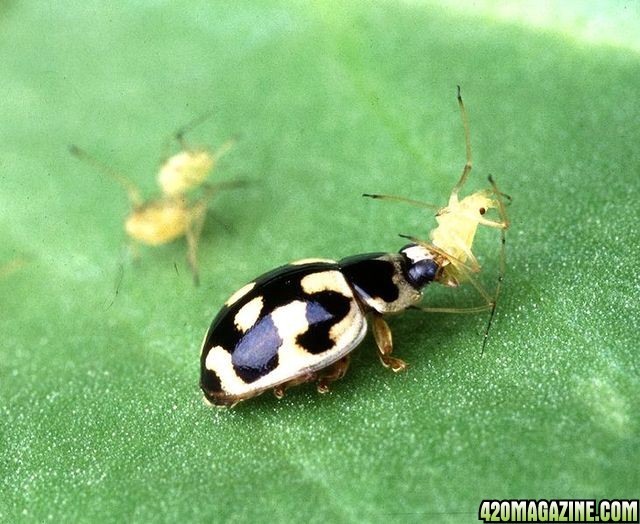
Ladybugs. Epic win
After looking through 420 magazine i noticed that there "PLANT AND PEST GUIDE" doesnt have pests so iv taken some time to upload this fantastic guide and i hope it can help many generations to fight off them pesky little critters!
Navigation
Install the app
How to install the app on iOS
How To Use Progressive Web App aka PWA On 420 Magazine Forum
Note: This feature may not be available in some browsers.
More options
You are using an out of date browser. It may not display this or other websites correctly.
You should upgrade or use an alternative browser.
You should upgrade or use an alternative browser.
Guide To Identifying Your Pests
- Author Dresney
- Create date
GodSpeed;1399671 said:
Blog entry information
More entries in Member Blogs
-
Is Cannabis Market Transforming into a Fast-Moving Consumer Goods (FMCG) Sector?Traditionally, the global cannabis consumption market was viewed mainly as a raw material...
-
The Rise of Skate Vape: A New Design Trend in Cannabis ConsumptionAs the cannabis vaping market continues to evolve, new product trends are emerging that push the...
-
Why the Vape with Screen is Gaining Popularity in Cannabis?The cannabis vaporizer industry is evolving rapidly, and one trend that has gained significant...
-
How to Choose the Right Cannabis Vape with A Screen for YouAs the cannabis industry rapidly evolves, the competition among suppliers has intensified...
-
Why Are More Cannabis Brands Introducing Vapes with Screen Display?As the cannabis industry rapidly evolves, the competition among suppliers has intensified...


